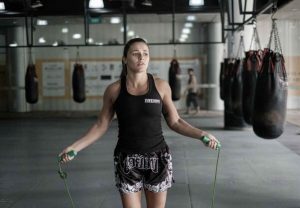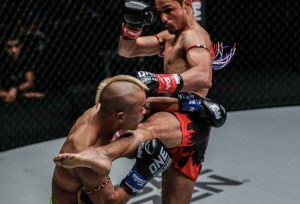Muay Thai training at home: The gym serves as a home away from home for a lot of us. However, wouldn’t it be lovely if our house doubled as our gym? This article will cover training with just your body and minimal equipment in any setting and without any partners.
It is hoped that reading this post will encourage you to accept constructive limitations. While that may seem contradictory, one should operate under the knowledge that there are instances in which thinking inside the appropriate box is preferable to thinking outside of it.
It’s time to use your imagination. First and foremost, let us start with principles, as we always should.
Principles for Muay Thai training at home:

1. Single Focus:
Building muscle memory and habits is the key to fighting. If a man tried to give up smoking, commit to exercising, go vegan, and start sleeping earlier, how do you think he would fare? He would not succeed.
Your progress will be easy to measure and, consequently, easy to manage if you have a single, clear goal. We need to first develop our confidence before we can learn. Set one very specific goal and focus all of your efforts on it (e.g., practising the pivot for a right high-kick).
2. Reduce Complexity:
It’s acceptable to start out small. Start small and progress gradually. The first step is the hardest, so take it easy.
3. Clarity in principles:
Since principles are flexible and wide, honing them should be the first step in learning any skill. Remember that principles are just rules, and rules are supposed to be followed, not broken.
Whether you want to learn a language or fight, the aforementioned principles are meant to be broadly applicable to all skills. The training techniques listed below are designed specifically for fighting, but there are still some general guidelines.
Muay Thai solo training methods:

1. Shadowboxing:
One of the best warm-ups you can do is shadowboxing because it simulates fighting conditions and lets you practice form and technique correctly.
Fighting is akin to muscle memory, so the more opportunities you have to practice appropriate striking and footwork techniques, the more proficient you will become. You are cultivating sloppiness if you are not cultivating quality.
2. Work the tree, nature’s heavy bag:
This approach builds on shadowboxing (thus, 1B), which we’re going to enhance by adding a punching bag or tree in order to address a shadowboxing deficit.
The “body only” rule is not broken in my opinion because trees are present everywhere. So long as you’re not in a desert—where cacti may exist, but it wouldn’t be advisable to strike or kick them—you should be able to apply this technique.
This emphasizes the need for accuracy and good form even more. In this case, cultivating quality is more important than in shadowboxing; although you won’t get hurt if you punch the air with bad form, should you punch a tree with shoddy technique? A wrist can be broken with ease.
Consider striking a solid object as solidifying your technique; this is the crucial moment to remove the scaffolding and training wheels. Next, we assess the state of your technique.
3. Study fights:
Much like reading a book, watching a fight shouldn’t be considered a passive activity. Reading a book or watching a fight are two examples of interactive activities that call for reciprocal communication between the viewer and the material being read or viewed.
Reading, fighting, or any other process needs to be active. So how, one might wonder, do we make reading and watching an active process? through posing queries.
Exercises to improve Muay Thai skills:
1. Skipping Rope:

Skipping rope is a good way to warm up before doing more strenuous exercises. Additionally, it strengthens your ankles and feet, increasing their resistance to injury during kicking.
Because we have to pay attention to the rhythm of our foot movements while our hand continuously spins the rope, it also aids in concentration. If done consistently, this also improves brain and nerve function. Our various organs will eventually function more harmoniously.
2. Blocking And Kicking Combos:

Here’s another Muay Thai technique that you can practice without any special equipment at home. Shadowboxing as though you’re blocking left and right kicks is a good way to start. Throw a push kick (called a teep in Thai) after standing on one foot with the other up to block for three seconds.
Imagine someone catching the kick as you toss it, and if you can, hold it there for ten seconds or more. Kick from the left and right in turn.
3. Punching And Sprinting:

Running and sprinting are the next exercises, and you have to really work yourself into this. In the absence of a pad holder, you are responsible for this.
Perform three minutes of uninterrupted jab-cross punches interspersed with interval sprints for the first round. Consider your sprint as a jog for the first 30 seconds. Try running as fast as you can for the next thirty seconds.
Repeat this for two rounds. If three minutes isn’t long enough, extend the duration to five minutes each round.
4. Alternating Knees:

Dejdamrong Sor Amnuaysirichoke, a former ONE Strawweight World Champion, shadowboxes and throws an air knee. Without a bag, this technique is different, but if you persevere, the benefits will be felt. Begin by shadowboxing for three minutes while launching your left and right knees.
As you throw your knees for the first thirty seconds, pay close attention to technique, maintaining a strong, balanced gait and pointing your toes downward. Then, double up your knees for the next thirty seconds. But this time, pay closer attention to speed.
Make sure your knees are nice and high in both situations. Attempt to complete two rounds of each drill; if, after three minutes, you are not feeling the burn, increase the time to five minutes per round.
5. Sit-Ups:

Thai athletes are renowned for their incredible abs in addition to their incredible conditioning. Just take a look at ONE Flyweight Muay Thai World Champion Rodtang “The Iron Man” Jitmuangnon and his amazing six-pack if you need any reminders.
Thankfully, genetics has nothing to do with it; all you need to do is dedicate yourself to performing hundreds of sit-ups every day. You have many reasons to reach those numbers because you are alone at home.
For Rodtang, the advantages of sit-ups extend well beyond appearance. Play some music, and go slowly. You may take as many breaks as necessary; you are not required to perform hundreds of sit-ups at once. Start off with a goal of 200 sit-ups, and see if you can work your way up to 500 a day.
So, this was all about the steps for Muay Thai training at home. Also read, Cricketer Virat Kohli does Bhangra after win in Newlands

